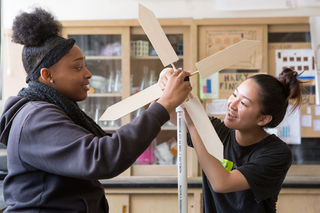Career
How to Change Behavior for Good
Long-term change is an elusive goal. A new model helps to explain how it's done.
Posted April 7, 2020

The catchphrase of one of my all-time favorite television characters, Dr. Gregory House, is “people don’t change.” If House is right, does that mean all of us who do intervention science are chasing windmills?
I would contend that people do change all of the time. Right now we’re seeing behavior change to a remarkable degree related to COVID-19. We actually know a lot about how to get people to change ... at least for a short time. The tricky part is preventing people from reverting to their past behavior. I think what House really meant is that “people don’t change for good.”
Lasting change, therefore, has always been a holy grail of sorts for intervention research, whether we’re talking about study skills, hand washing, diet and exercise, alcohol use, or sleeping habits. In many ways, the goal of this blog has been to share with you the kinds of interventions that have shown long-term impact on students’ behavior, such as communal (pro-social) interventions, self or values affirmations, and growth mindset interventions. Although there is convincing evidence for the impact of these interventions on student outcomes, what’s been elusive is evidence on why they work, and it’s the why that allows us to translate these methods to unique populations and circumstances. A new psychological model of behavior change, however, gives us an exciting and innovative framework for thinking about how to design interventions for long-term impact.
How Parents Can Influence Students’ STEM Outcomes
To illustrate this model, I first want to share a fascinating study that increased high school students’ interest in STEM by changing their parents’ mindsets. Utility-value (UV) interventions refer to any exercise that helps students to consider the usefulness of what they’re learning in both the short- and long-term, as well as for both their personal and (future) professional lives. Research led by Dr. Judith Harackiewicz, professor of psychology at the University of Wisconsin, has demonstrated that UV interventions are particularly effective at improving performance in science courses and motivating students to continue studying STEM.

We know that parents’ attitudes toward science and math influence their children’s interest in STEM, so could a UV intervention delivered to parents change their children’s behavior? The intervention was fairly simple: Parents of nearly 100 high school sophomores received two brochures with tips on how to talk to their child about the utility of school and, in particular, science and math. Parents also received access to a website with further guidance on how to help their children make important decisions about their education during their final years of high school. In over 80% of families, these materials were accessed and used by at least one parent when talking to their child about school.
The brochures and website had the intended effect of strengthening parents’ beliefs that math and science are useful for their child compared to control parents. More importantly, students whose parents received the UV intervention took an average of one semester more of advanced science and math during high school, and scored higher on the ACT science and math sections. Furthermore, these students graduated high school with a stronger belief in the value of learning STEM.
Even more impressive, students in the intervention group still perceived more value in STEM than the control students—a full five years later! Moreover, these students took more STEM courses in college, were more likely to declare a STEM major, and reported stronger intentions to enter into a STEM-related career. These long-term effects are especially remarkable given that they were entirely indirect: no intervention was ever targeted to the students themselves.
How Did the Intervention Work?
I mentioned earlier a new model for thinking about how an intervention creates long-term behavior change. According to this framework, interventions can have a lasting impact via three unique mechanisms: chains of events, feedback loops, and reflexive mindsets. Let me unpack those terms within the context of the parental UV intervention.
When I think of a chain of events, my mind goes right to a Rube Goldberg machine: An alarm clock rings, vibrating a rock onto a Ferris wheel, which spins and tips over a cup, which rolls rubber balls into a bucket, and so on. The parental UV intervention can probably best be understood in these terms. We know that the brochures and website prompted more conversations between parents and their children about high school course selections, which resulted in students taking more advanced science and math classes. We can infer the rest of the chain: students in these advanced courses did better on their ACTs, which motivated them to take more STEM courses in college, which led them to major in STEM, and so forth. Although the intervention is long over, perhaps even forgotten, its impact can be felt so long as the chain of events proceeds unbroken.
If you’re familiar with the concept of wise interventions, then you’re probably familiar with feedback loops. A wise intervention changes behavior by modifying an individual’s beliefs underlying that behavior. Long-term change occurs when that new behavior is rewarded, thereby reinforcing those beliefs and making it more likely that the new behavior is performed again in the future. The long-term effects of the parental UV intervention could represent a unique situation in which a chain of events triggers a feedback loop. Again, we have evidence that parents in the intervention guided their children to take more advanced science and math classes. Better ACT scores (and perhaps grades) followed, which likely elicited praise or a sense of personal accomplishment, rewards that would reinforce students’ beliefs that STEM is useful. These feedback loops, kick-started by the brochures and website sent to parents, could then persist through college and beyond.
Finally, interventions can teach people reflexive mindsets that they fall back on in novel situations. In the parental UV intervention, two reflexive mindsets seem plausible. First, we know that parents spoke to their children more about their high school class selections. It’s possible that parents continued to advise their children to take STEM courses in college, perhaps even advocating for a STEM major and STEM career intentions. Second, students may have absorbed from their parents the importance of considering the utility of science and math. If these reflections became habitual, students might respond differently to challenges faced in STEM, excel in their STEM courses, and remain in the STEM pipeline.
Building Interventions for Long-Term Impact

It’s rare that we design an intervention with the ultimate goal to change one behavior, one time. To date, however, we haven’t had the framework at hand to design interventions with long-term behavior change in mind. These three mechanisms—chains of events, feedback loops, and reflexive mindsets—could serve as a litmus test for whether a new intervention could produce lasting effects. Although it has taken nearly a decade to delineate the long-term pathways from the parental UV intervention to students’ behavior, you could ask yourself a few questions during the design phase to determine your intervention’s capacity to produce long-term change.
- Could this intervention trigger a chain of events, and what would that look like? When and how could the chain be disrupted?
- How might students’ beliefs targeted by this intervention be reinforced (or extinguished) by the environment?
- Can this intervention create mindsets or skills that students will reflexively turn to in future challenging circumstances? Could those mindsets generalize to novel situations?
References
Harackiewicz, J. M., Rozek, C. S., Hulleman, C. S., & Hyde, J. S. (2012). Helping parents to motivate adolescents in mathematics and science: An experimental test of a utility-value intervention. Psychological Science, 23(8), 899-906.
Hecht, C. A., Priniski, S. J., & Harackiewicz, J. M. (2019). Understanding long-term effects of motivation interventions in a changing world. Advances in Motivation and Achievement: A Research Annual, 20, 81-98.
Rozek, C. S., Svoboda, R. C., Harackiewicz, J. M., Hulleman, C. S., & Hyde, J. S. (2017). Utility-value intervention with parents increases students’ STEM preparation and career pursuit. PNAS, 114(5), 909-914.
Walton, G. M. (2014). The new science of wise psychological interventions. Current Directions in Psychological Science, 23(1), 73-82.




